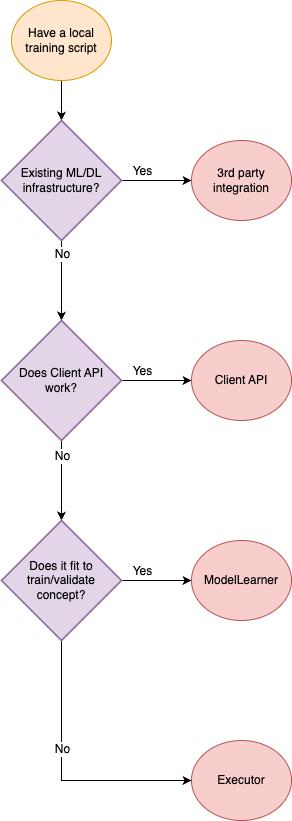From Local to Federated¶
In the FLARE system, a federated learning algorithm is defined in a Job format (for details, please refer to Job).
A Job consists of multiple “workflows” and “executors.”
The simplified job execution flow is as follows:
The workflow schedules a task for the FL clients.
Each FL client performs the received task and sends the result back.
The workflow receives the results and determines if it is done.
If it is not done, it schedules a new task
If it is done, it proceeds to the next workflow in the Job.
Users need to adapt their local training or computing logic into FLARE’s task execution abstractions to make their training or computing federated.
We offer various levels of abstraction for writing task execution code, catering to use cases that span from complete customizability to easy user adaptation.
Execution API Type¶
Below is a general overview of the key ideas and use cases for each type:
Client API¶
The Client API provides the most straightforward way to write FL code,
and can easily be used to convert centralized code with minimal code changes.
The Client API uses the FLModel
object for data transfer and supports common tasks such as train, validate, and submit_model.
Additionally, options for using decorators or PyTorch Lightning are also available.
We recommend users start with the Client API, and to consider the other types for more specific cases as required.
ModelLearner¶
The Model Learner is designed to simplify writing learning logic by
minimizing FLARE-specific concepts.
The ModelLearner
defines familiar learning functions for training and validation,
and uses the FLModel
object for transferring learning information.
The ModelLearner also contains several convenient capabilities,
such as lifecycle and logging information.
The ModelLearner is best used when working with standard machine learning code that can fit well into the train and validate methods and can be easily adapted to the ModelLearner subclass and method structure.
Executor¶
Executor is the most flexible for defining custom logic and tasks,
as with a custom executor and controller, any form of computation can be performed.
However, Executors must deal directly with FLARE-specific communication concepts
such as Shareable, DXO,
and FLContext.
As a result, many higher-level APIs are built on top of Executors in order to
abstract these concepts away for easier user adaptation.
Overall, writing an Executor is most useful when implementing tasks and logic that do not fit within the structure of higher-level APIs or other predefined Executors.
3rd-Party System Integration¶
There are cases where users have a pre-existing ML/DL training system infrastructure that cannot be easily adapted to the FLARE client.
The 3rd-Party System Integration pattern allows for a seamless integration between the FLARE system and a third-party external training system.
With the use of the FlareAgent and
TaskExchanger,
users can easily enable any 3rd-party system to receive tasks and submit results back to the server.
Please use the following chart to decide which abstraction to use:

For more details about each type, refer to each page below.